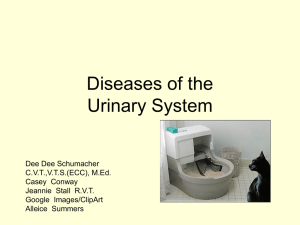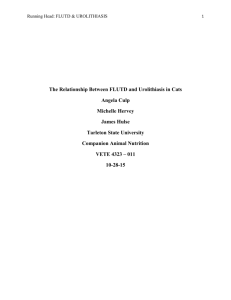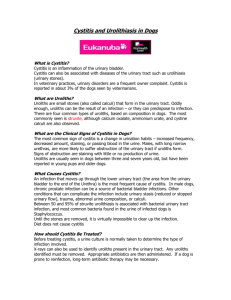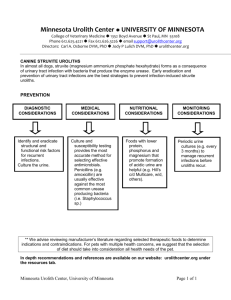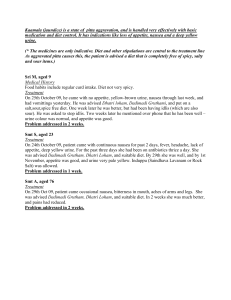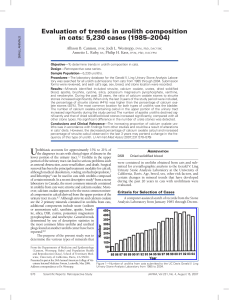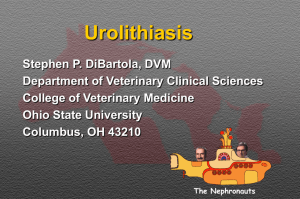Ettinger: Textbook of Veterinary Internal Medicine, 7th Edition
advertisement
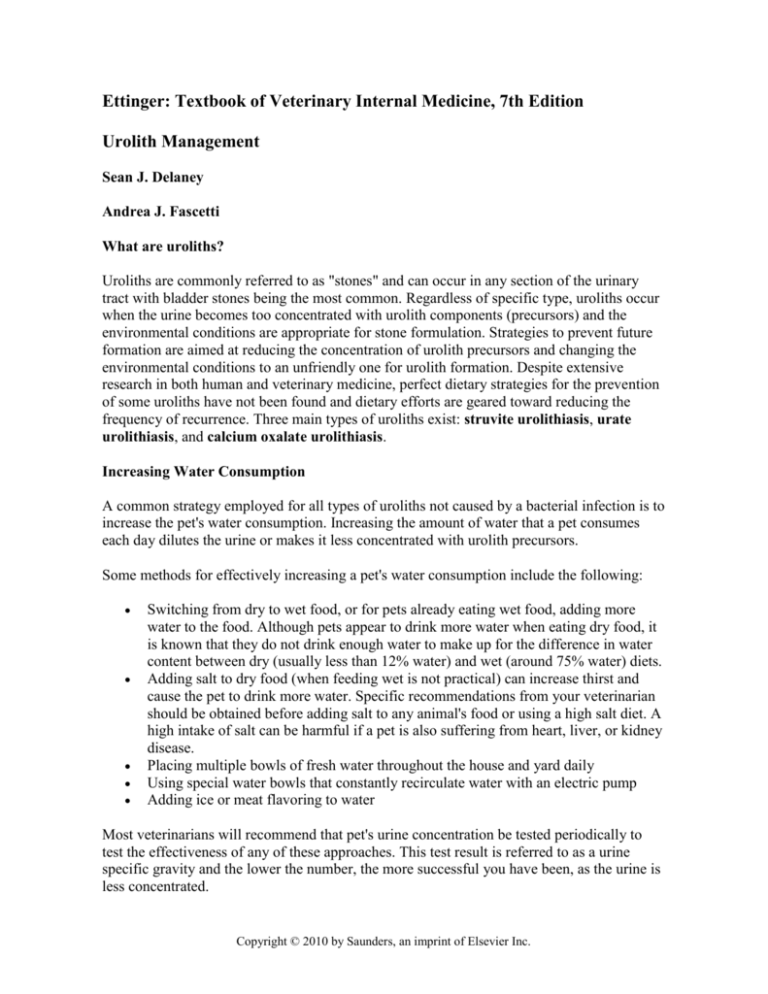
Ettinger: Textbook of Veterinary Internal Medicine, 7th Edition Urolith Management Sean J. Delaney Andrea J. Fascetti What are uroliths? Uroliths are commonly referred to as "stones" and can occur in any section of the urinary tract with bladder stones being the most common. Regardless of specific type, uroliths occur when the urine becomes too concentrated with urolith components (precursors) and the environmental conditions are appropriate for stone formulation. Strategies to prevent future formation are aimed at reducing the concentration of urolith precursors and changing the environmental conditions to an unfriendly one for urolith formation. Despite extensive research in both human and veterinary medicine, perfect dietary strategies for the prevention of some uroliths have not been found and dietary efforts are geared toward reducing the frequency of recurrence. Three main types of uroliths exist: struvite urolithiasis, urate urolithiasis, and calcium oxalate urolithiasis. Increasing Water Consumption A common strategy employed for all types of uroliths not caused by a bacterial infection is to increase the pet's water consumption. Increasing the amount of water that a pet consumes each day dilutes the urine or makes it less concentrated with urolith precursors. Some methods for effectively increasing a pet's water consumption include the following: Switching from dry to wet food, or for pets already eating wet food, adding more water to the food. Although pets appear to drink more water when eating dry food, it is known that they do not drink enough water to make up for the difference in water content between dry (usually less than 12% water) and wet (around 75% water) diets. Adding salt to dry food (when feeding wet is not practical) can increase thirst and cause the pet to drink more water. Specific recommendations from your veterinarian should be obtained before adding salt to any animal's food or using a high salt diet. A high intake of salt can be harmful if a pet is also suffering from heart, liver, or kidney disease. Placing multiple bowls of fresh water throughout the house and yard daily Using special water bowls that constantly recirculate water with an electric pump Adding ice or meat flavoring to water Most veterinarians will recommend that pet's urine concentration be tested periodically to test the effectiveness of any of these approaches. This test result is referred to as a urine specific gravity and the lower the number, the more successful you have been, as the urine is less concentrated. Copyright © 2010 by Saunders, an imprint of Elsevier Inc. Client Information Sheets 2 Struvite Urolithiasis Struvite uroliths comprise magnesium, ammonium, and phosphates and tend especially to form in urine that is alkaline (higher pH). In dogs, struvite crystals commonly occur when there is a concurrent urinary tract infection (UTI). In dogs that formed struvite uroliths as a result of a UTI, the prevention of recurrence is aimed at avoiding future UTI's with the use of antibiotics, and the dog's diet is usually not changed. Most cats and some dogs do not have UTI and the primary management of the disease is dietary. Dietary strategies to prevent struvite uroliths are primarily focused on decreasing the concentration of struvite precursors and acidifying the urine. Decreasing the struvite precursors is first accomplished by increasing water consumption by the methods discussed above. In addition, the amount of magnesium, ammonium, and phosphate in the diet are reduced. Because the majority of ammonium and phosphate in the urine comes from the protein in the diet, the diets designed to prevent or even dissolve struvite stones are low in protein. The amount of protein in foods designed to dissolve struvite uroliths is so low that careful monitoring of the pet is necessary when dietary dissolution of struvite uroliths is employed instead of surgical removal. This monitoring may include frequent and repeated radiographs (x-rays) to ensure that the diet is actually causing the stone to dissolve. Blood tests may also be recommended. Unfortunately, low-protein diets cause the urine to be alkaline, which increases the likelihood of struvite formation. To counter this effect, diets designed to prevent or dissolve struvite uroliths have urine acidifiers added to them such as the amino acid methionine. Close monitoring for a low urine specific gravity, low pH, and lack of struvite crystals with frequent urinalysis is crucial to effectively preventing recurrence of struvite uroliths. Urate Urolithiasis Urate uroliths primarily comprise uric acid or urate and usually form in pets that have a liver shunt, with the exception of dalmatians and possibly English bulldogs. In dalmatians and English bulldogs it is apparently a genetic defect in their ability to normally handle dietary purine. This defect results in the formation of urate uroliths. Treatment for dalmatians and possibly English bulldogs includes both diet and medication (i.e., Allopurinol). The amount of medication needed is dependent upon the amount of purine in their diet. Thus adjustments in medication must be based on analysis of urine collected after any dietary changes. For other animals that have uroliths, veterinarians will perform relatively extensive diagnostic testing to determine if the underlying cause is a liver shunt. A liver shunt occurs when blood from the intestinal tract bypasses the liver and goes directly into the body's bloodstream. This bypass prevents the normal by-products from digested and absorbed food from going to the liver for processing before being sent into the circulation. These byproducts remain in the circulation and can adversely affect some animals. These adverse Copyright © 2010 by Saunders, an imprint of Elsevier Inc. Client Information Sheets 3 affects are frequently manifested as neurologic signs, referred to as hepatic encephalopathy (HE). HE can be manifested as lethargy, "spacey" looks, or "star gazing," or even seizures. The onset of these clinical signs is frequently associated with the consumption of a meal. Foods high in protein are frequently associated with the development of clinical signs because one of the breakdown products of protein is ammonia. Ammonia is hypothesized to be a key trigger of HE. Pets with urate uroliths may never show signs of HE. Some shunts can be corrected surgically. If the surgery is successful and the shunt is corrected, some of these pets will not need long-term dietary changes. For dogs with a genetic predisposition and for dogs and cats in which surgery is not effective or not an option, the treatment of urate urolithiasis relies on the use of low purine diets. Purines are a component of DNA. DNA is found in high concentrations in common protein sources, although some types of proteins contain more than others. Organ meats have the highest purine content, and vegetable and dairy proteins have the lowest. Therefore cottage cheese or egg-based diets are commonly utilized, as are vegetarian diets for dogs. Cats have many special nutritional needs because they are carnivores. Therefore they cannot be managed with a vegetarian diet. This strategy can be effective but can lead to protein malnutrition if the animal is not eating enough food to meet its daily energy needs. Your veterinarian can measure blood concentrations to help monitor for this potential problem. The selection of low purine diets is often similar to the diets selected for treating HE, but again precautions are taken to avoid protein malnutrition. Most pets with signs of HE have a liver that is not as efficient at using dietary and thus actually need more protein and not less. This is why protein is not restricted in pets with liver disease unless they have signs of HE. Even when pets have signs of HE, many veterinarians will slowly increase the amount of protein in the diet (for example, by adding small amounts of cottage cheese) in an attempt to maximize the amount of protein the pet is getting without causing signs of HE. Calcium Oxalate Urolithiasis Calcium oxalate uroliths are comprised of calcium and oxalate and especially like to form in concentrated urine. The best nutritional approach remains to be determined and is somewhat controversial; however, certain dietary strategies appear to help reduce the frequency of recurrence and will be briefly mentioned here. As with most uroliths, increasing water consumption is important for prevention and with calcium oxalate uroliths it is vital. The above-discussed methods for increasing water consumption can all be employed, but some debate exists as to whether salt should be used due to the frequent existence of kidney disease in pets with calcium oxalate uroliths. Careful screening and monitoring of a pet's urine specific gravity (along with blood tests) should resolve this as a concern. Pets with kidney disease lose their ability to concentrate their urine; therefore adding salt to a pet's diet is useless when they already have a low urine specific gravity from renal failure. Thus pets who would be harmed from the addition of salt to their diet would not be appropriate candidates for this strategy. Copyright © 2010 by Saunders, an imprint of Elsevier Inc. Client Information Sheets 4 Reducing calcium and oxalate in the diet is another strategy that is used for prevention. Decreasing the amount of calcium in the diet must be done carefully. Decreasing calcium to low levels can actually cause oxalate in the diet to be absorbed at even greater amounts since calcium can bind to oxalate in the gut and prevent its systemic absorption. Decreasing oxalate in the diet is an effective strategy, but much of the oxalate in a pet's body is not from the diet but from the natural processing of other nutrients in the diet. In any event, avoidance of high oxalate containing treats such as many vegetables and fruits is an important preventative step. Ask your veterinarian about specific foods to avoid if you have questions about particular foods you like to feed your pet. One commonly employed dietary strategy that may not be as effective as originally proposed is decreasing dietary protein. Decreasing protein in the diet causes the urine to become more alkaline. A more alkaline urine was thought to discourage calcium oxalate formation in the urinary tract. Growing but somewhat controversial evidence indicates this is not the case. For now, focusing on prevention of calcium oxalate crystals in the urine and a low specific gravity appears to be the best method of decreasing the risk for recurrence of calcium oxalate uroliths. Copyright © 2010 by Saunders, an imprint of Elsevier Inc.

